January 29th, 2023
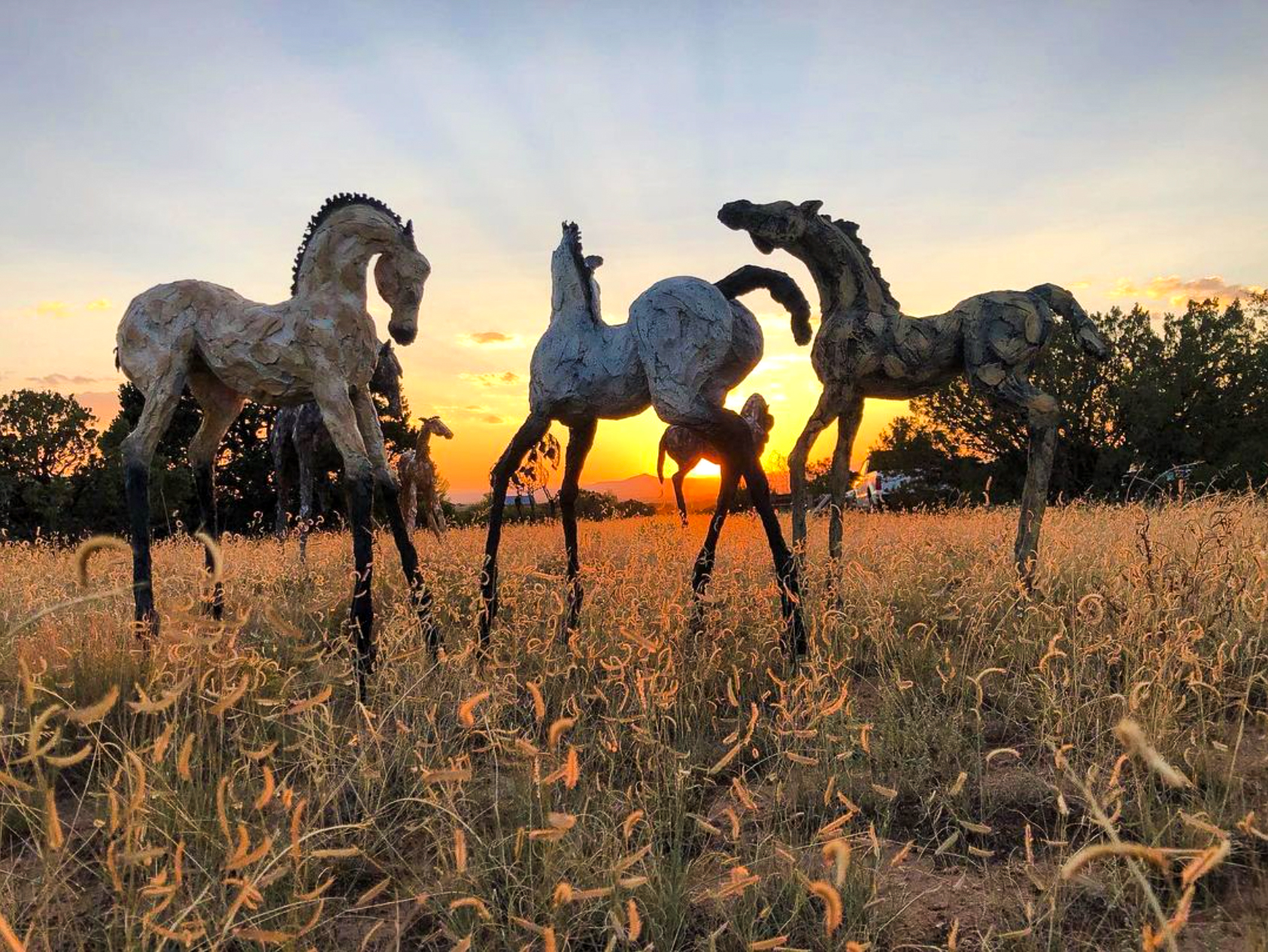
Three of Siri Hollander’s sculptures in front of the setting sun outside her studio in Santa Fe, New Mexico
We at Gallery MAR are thrilled to welcome the wild, majestic work of Santa Fe artist Siri Hollander. In our first conversation with the artist, we dove into her process and inspiration, behind all of which lies a fascinating story of a unique and free childhood lived on horseback in the rugged landscape of Andalusia:
Siri Hollander spent the majority of her childhood in the Andalusia region of Southern Spain in Màlaga Provence — an area that just so happens to be the birthplace of another famous artist: Pablo Picasso. To Hollander, the move to Màlaga, Spain seemed more or less spontaneous: “My parents moved to the Andalusia region of Spain from New York when I was very young. Basically, my dad told my mom it was a round trip, but the tickets were actually only one-way. He moved five kids, two dogs, and a cat across the Atlantic with only $600 in his pocket,” she remembers. Her father then rented a house for $90 a month: a huge house with a ten-stall cement barn attached.
At the time, Spain was really trying to bolster their tourism economy. Hollander describes Southern Spain at that time as an idyllic expat haven: “we were basically beyond free to do as we pleased,” she recalls, “it was like we had this playground where there were almost no rules. It was very, very different from anywhere I had ever been.”
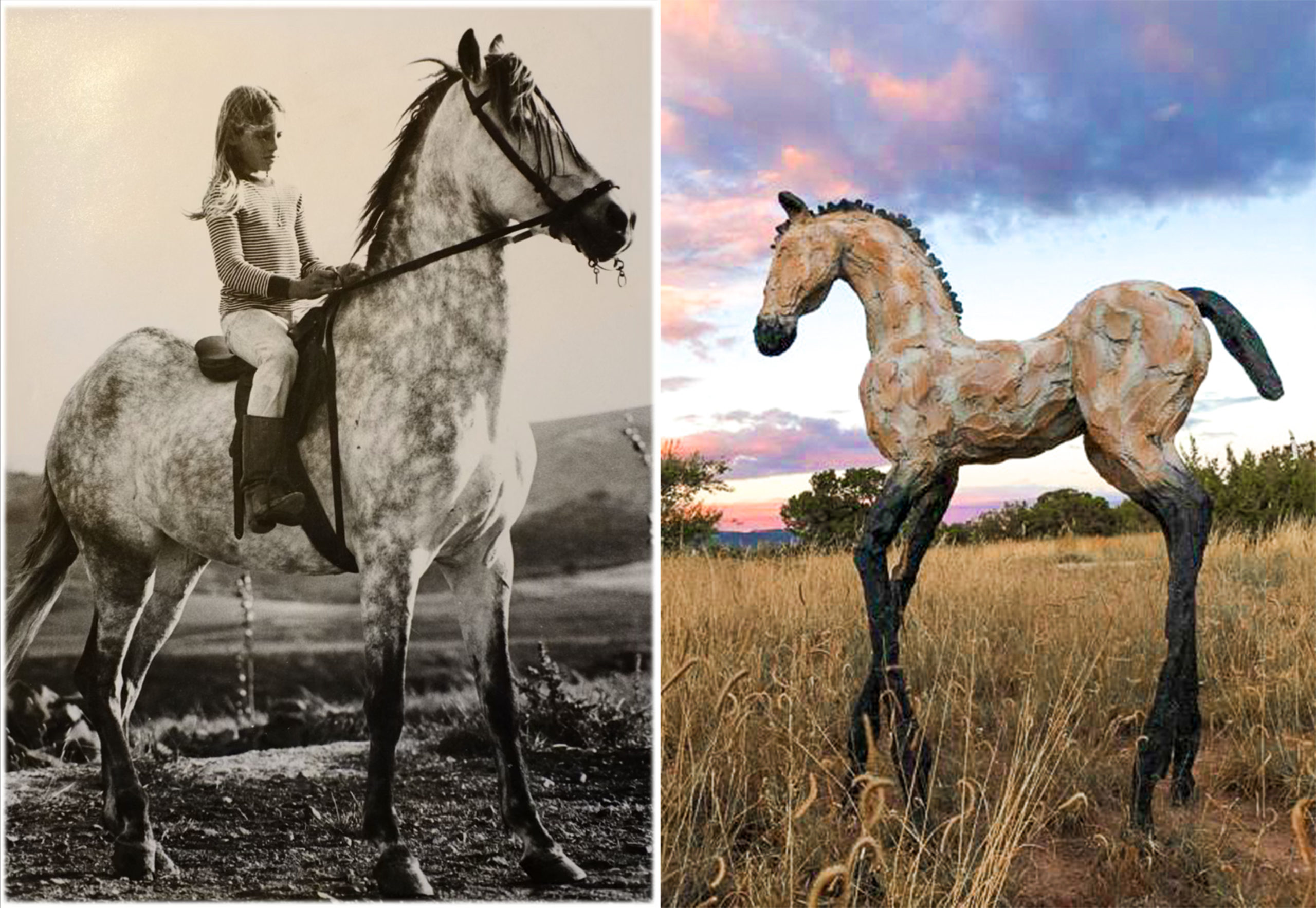
Left to right: Siri Hollander, aged 9, riding one of her family’s Andalusian horses, as she did “all day, every day.” | Siri Hollander’s 43″ x 34″ x 12″ aluminum sculpture, “Pipa 2/30“
Sometime early on in her childhood, a villager nearby who owned 20 horses got into some trouble, fled town, and abandoned his horses. “Some people in the town called my dad and they were looking around for people to adopt these horses,” Hollander recollects, “so he went over there and saw the scene. He then came home with all 20 horses. My dad just said, ‘we’re horsemen now.’ We went from never having been around a horse in our lives, to being on horses ally day, every day thereafter.” The family went to fairs with their horses, got all dressed up in the traditional attire, participated in fiestas and showed their horses at events. They learned to quickly and wholly embrace horsemanship.
“My family went from never having been around a horse in our lives, to being on horses all day, every day thereafter.”
– Siri Hollander
In Spain, with her family, pets, and 20 horses, Hollander experienced a uniquely free-range childhood, educated by nature, their horses, and the wild, rugged landscape of Andalusia. It became quite routine for her and her brothers to ride their massive Andalusian mares from dawn to dusk, with her parents only knowing the general direction in which they embarked. “My parents never really knew where we were all day,” she says. “I feel very blessed to have been raised in that era, because I know that that style of parenting isn’t really an option in today’s world.”

Siri Hollander and her family on a 30-day horse trip across Spain
During this time, Hollander and her siblings were homeschooled. Their parents would teach them some traditional coursework but always with an emphasis on history, especially local history. They would take trips together to visit local Roman ruins. Local shepherds share stories about the history of the village and tour the family around on occasion, picking up rare coins and various viejos, or “old things,” along the way.
Hollander recounts one especially memorable trip to the Cueva de la Pileta, which translates to “The Cave of the Pool” in English: “We were friends with these sheep herders who found a hole from a cave that had been reopened in the 70s. They called my dad because he was ‘the crazy American’ that liked to explore. My older brothers were photographers, so we went to the cave. They tied ropes around us, because we were little, and they would tell us to go down these holes and tell them if there was any art on the walls, any paintings.”

Cave paintings inside Cueva de la Pileta in Southern Spain. Photo courtesy of cuevadelapileta.es
Harnessed to the surface by hemp ropes, Hollander and her brothers were lowered into holes within the Cueva de la Pileta, a cave first discovered in the 1900s. As a very young girl, Hollander could squeeze into the smallest of the holes, spelunking for art with kerosene lamps as big as she was. The small cave holes eventually opened up into a great hall where ancient people had lived for thousands of years, leaving in their wake drawings upon the cave walls.
“I dream of horses. I project things that people do through horse mannerisms. I relate very much to horses and they just make me happy. They love me like part of their herd.”
– Siri Hollander
“A lot of the cave art was of animals or hunting scenes or possibly some spiritual deities,” she recalls, “There was a painting of this horse and of a bunch of deer running on the wall. The rocky textures of the wall were rough and uneven, which are textures that I use in my work today, so I believe that that experience made a big impression on me and likely inspired what I ended up doing with my own art.”

Siri Hollander at age 16, welding her early sculptures. As Hollander adds jokingly, she’s sculpting “with not a care for protection, as kids are”
The textures and subject matter of these ancient cave paintings are not the only elements that Hollander found inspiration in: Thousands of years ago, these cave paintings were created with iron oxide or manganese mixed with animal fat. These are now the same pigments and materials that Hollander uses to create her work today.
Between riding her horses all day everyday and discovering Paleolithic horse cave paintings as a child, it’s no wonder that horses became a natural focal point of Hollander’s artwork. Horses have and always will be an essential part of Hollander’s life. “I still have horses,” Hollander says, “I dream of horses. I project things that people do through horse mannerisms. I relate very much to horses and they just make me happy.” After a lifetime of love for these majestic creatures, Hollander has learned how to curate a respectful relationship with her horses, and all animals for that matter. “I try to let them be as opposed to making them obey,” she explains, “it does not make for very well-rounded horses, but it enriches our bond and they love me like part of their herd.”
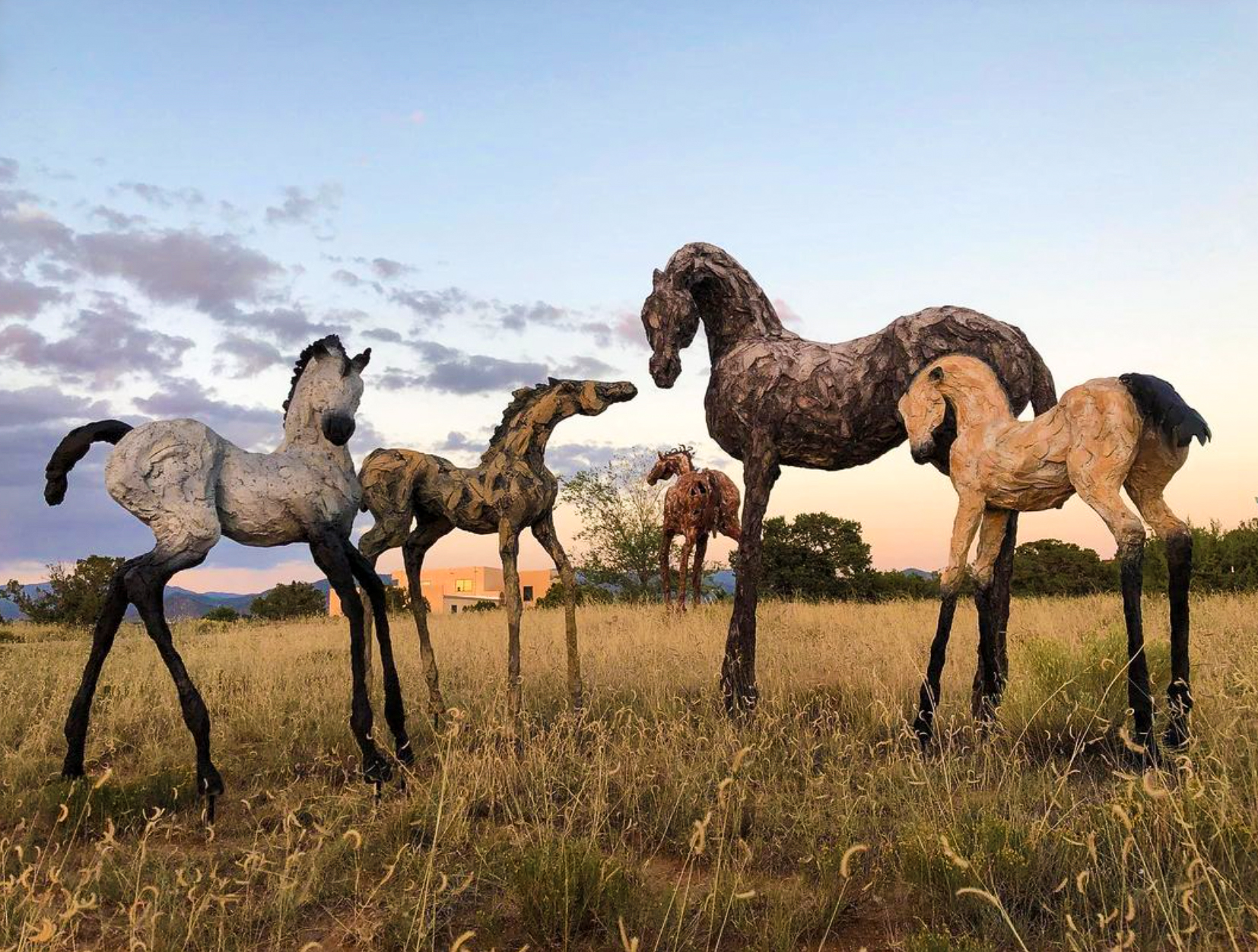
A “herd” of Siri Hollander’s aluminum and cement sculptures in Santa Fe
When she wasn’t out riding her Andalusian horses, Hollander could be found sketching, molding clay, or playing in her father’s art studio. From early on, she was drawn to the meditative state of creation, peacefully molding clay while her father painted. Although her father was considered more of the established artist in the family, her entire family was no stranger to creativity and adventure.
Her father was a painter, her brothers were photographers, and her mother had the greatest artistic eye. “My mother was absolutely brilliant artistically, but she was more of a passive personality,” Hollander recalls, “so she struggled getting that creativity from inside her mind into the outside world. So when her and my dad connected, she fed off of his momentum, and a lot of his great artistic creations were born of her ideas.”
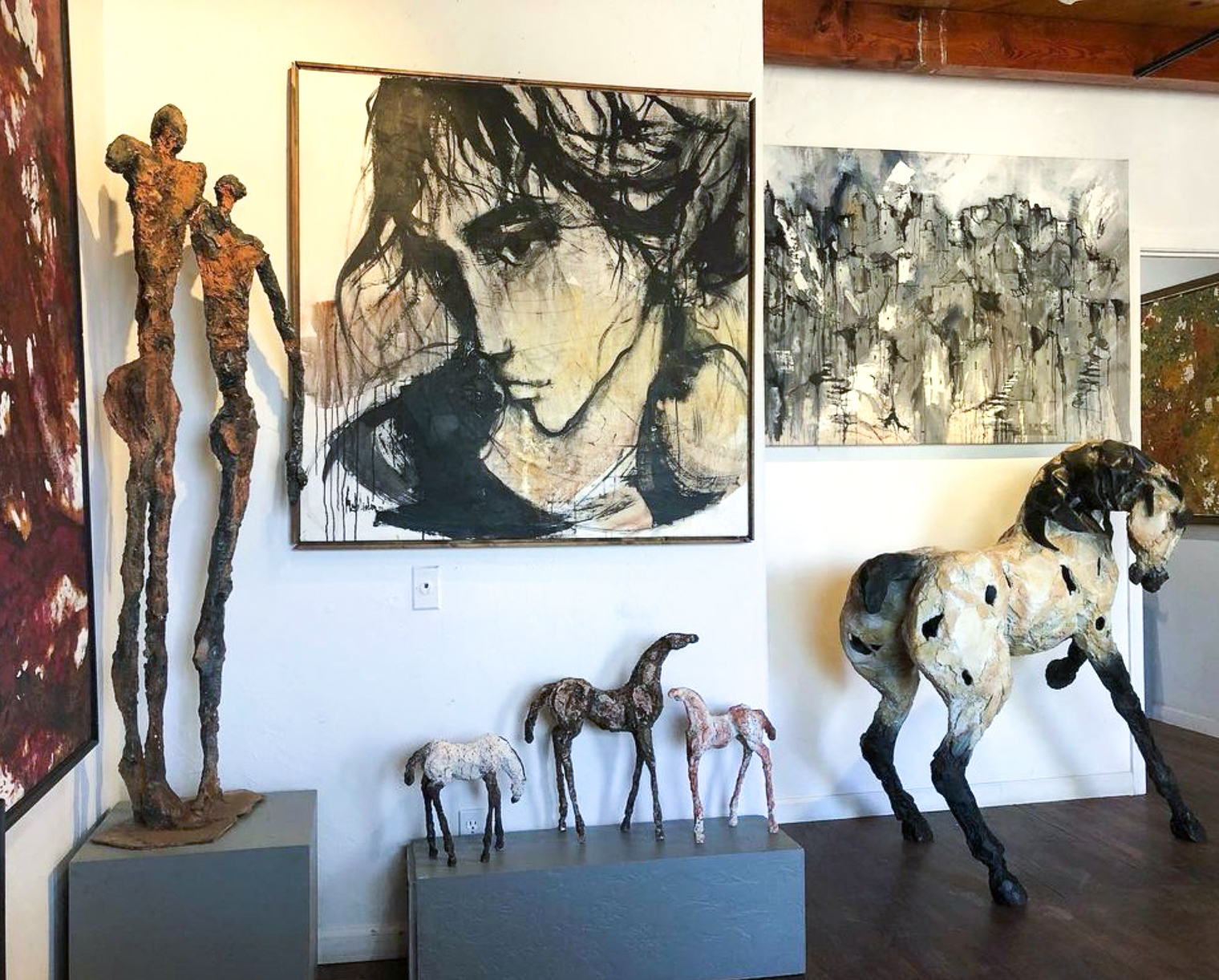
Siri Hollander’s sculpture work surrounding her late father’s paintings
Growing up in a creative family, Hollander recognizes how aspects of her parents’ work and personalities have bled into her own artwork. She believes that genes make up much of who we are and “art is who you are;” therefore, “it comes through you.” Much like her father, Hollander finds that her work emphasizes emotion and expression over precision and perfect realism. “[In both my work and my father’s work], we aim more for the mood and then we go for the details. We’re both very impatient people, and we like things to happen quickly, so it’s about capturing a moment and then stopping ourselves from overdoing it.”
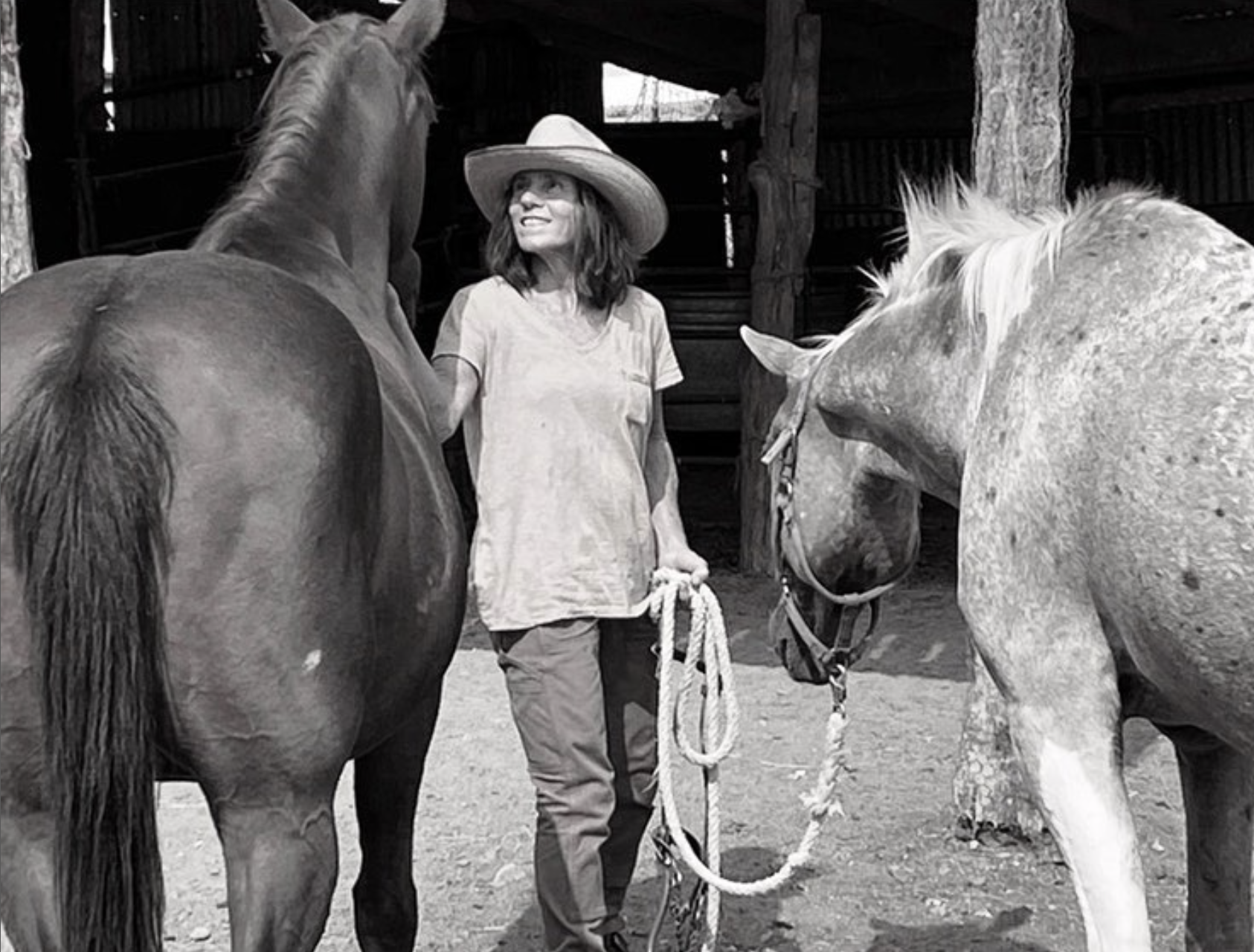
“Me and my boys taken by my dear friend Darleen” – Siri Hollander
After spending the entirety of her childhood wild and free in Southern Spain, Hollander returned to the United States at age 19, fiercely independent, self-assured, and, admittedly, a little unsocialized. For Hollander, horses and animals, with their pure emotions and unadulterated authenticity, made more sense to her than people.
She enjoyed a brief stint in the Northwoods of Vermont but found the cold winters to be too foreign and jarring. So she moved from one coast to the other and found herself in sunny Santa Barbara. Although the sun-soaked terrain was a welcome reprieve, she found the community there to be too much of a culture shock from the life she was accustomed to. When a friend spontaneously suggested a move to Santa Fe, she jumped at the chance and never looked back.
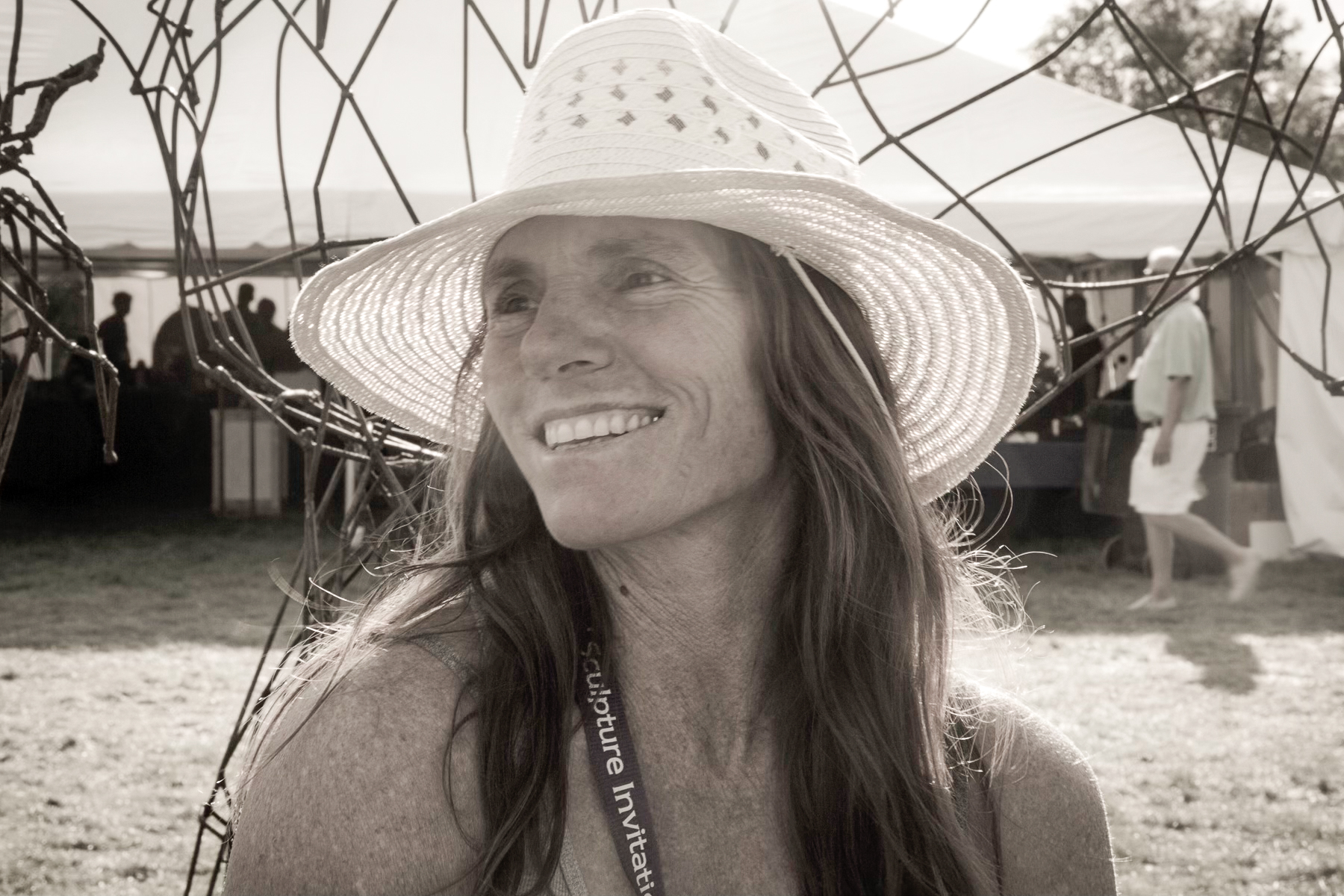
Artist Siri Hollander in Santa Fe, New Mexico
Now Hollander lives in a more rural community in the mountains outside Santa Fe, home to a small blended faction of Native American and Spanish communities. Here she can speak Spanish freely with her neighbors and immerse herself once again in the Spanish culture and values that she was raised with.
“In Santa Fe, the weather is out of your hands and you can either see that and enjoy the wildness of it or you can be annoyed by it. It’s a lot of elements of nature that are apparent all the time. I like the roughness of it. I feel comfortable in it.”
– Siri Hollander
This sense of home within her community is strengthened by the natural ruggedness and beauty of the Southwest. “You’ll have a beautiful, lovely day and then the next day, you just get blown to shreds or you get snowed on,” Hollander says of her now home, “The weather is out of your hands and you can either see that and enjoy the wildness of it or you can be annoyed by it. The sun is fairly severe, the wind is very intense, and the winter can be very cold. It’s a lot of elements of nature that are apparent all the time. I like the roughness of it. I feel comfortable in it.”
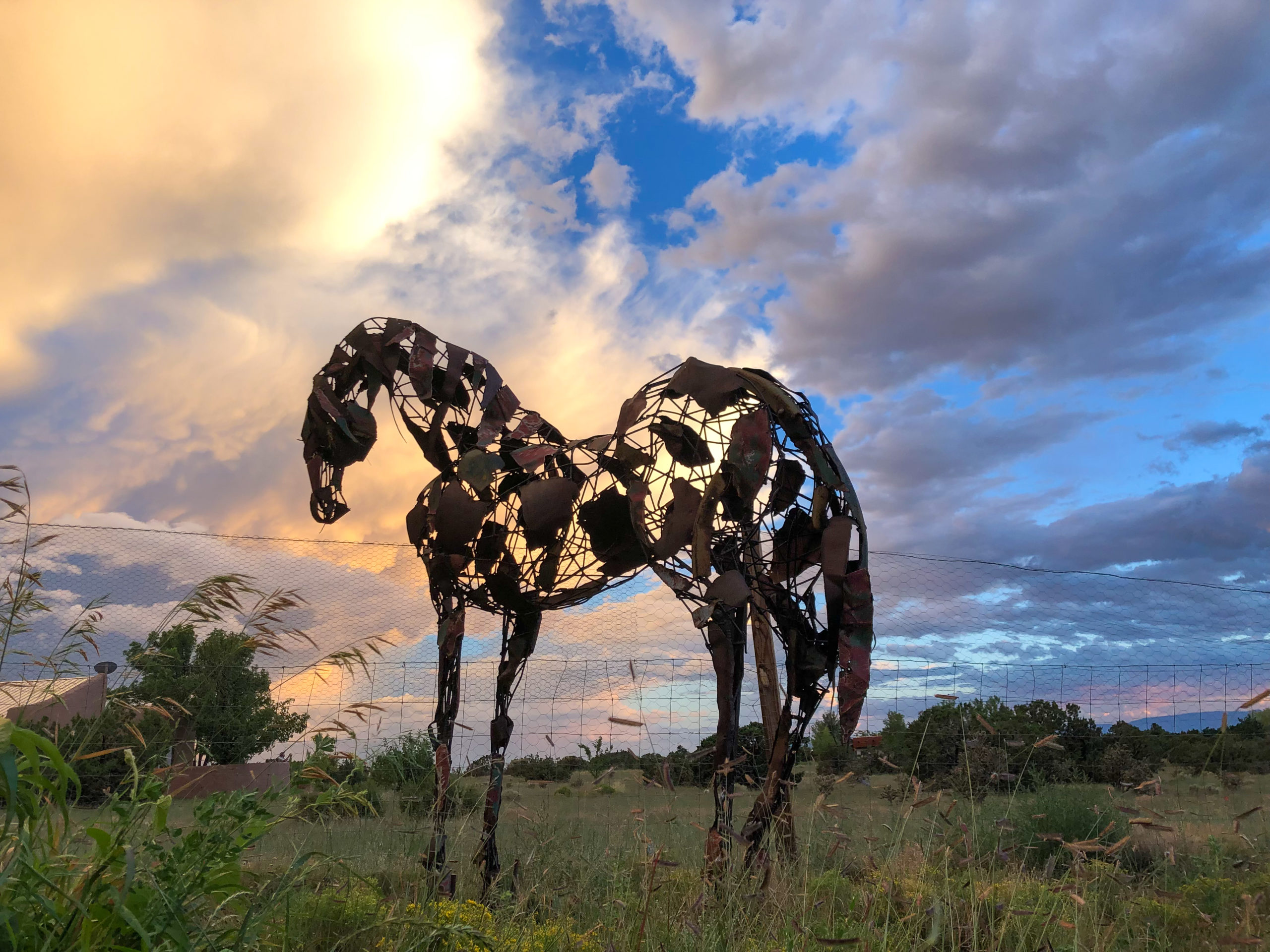
A mixed media sculpture by Siri Hollander
For the most part, Hollander creates her pieces outside in this rough and wild landscape, and that wildness inevitably finds its way into her work. Battling the elements in ever-changing conditions is an aspect of her work that she is acclimated for. It even influences the materials she chooses to use. Hollander prefers a life that reflects the fierceness, and occasional harshness of reality, so her work is of the elements, created in the elements, and meant to withstand the elements.
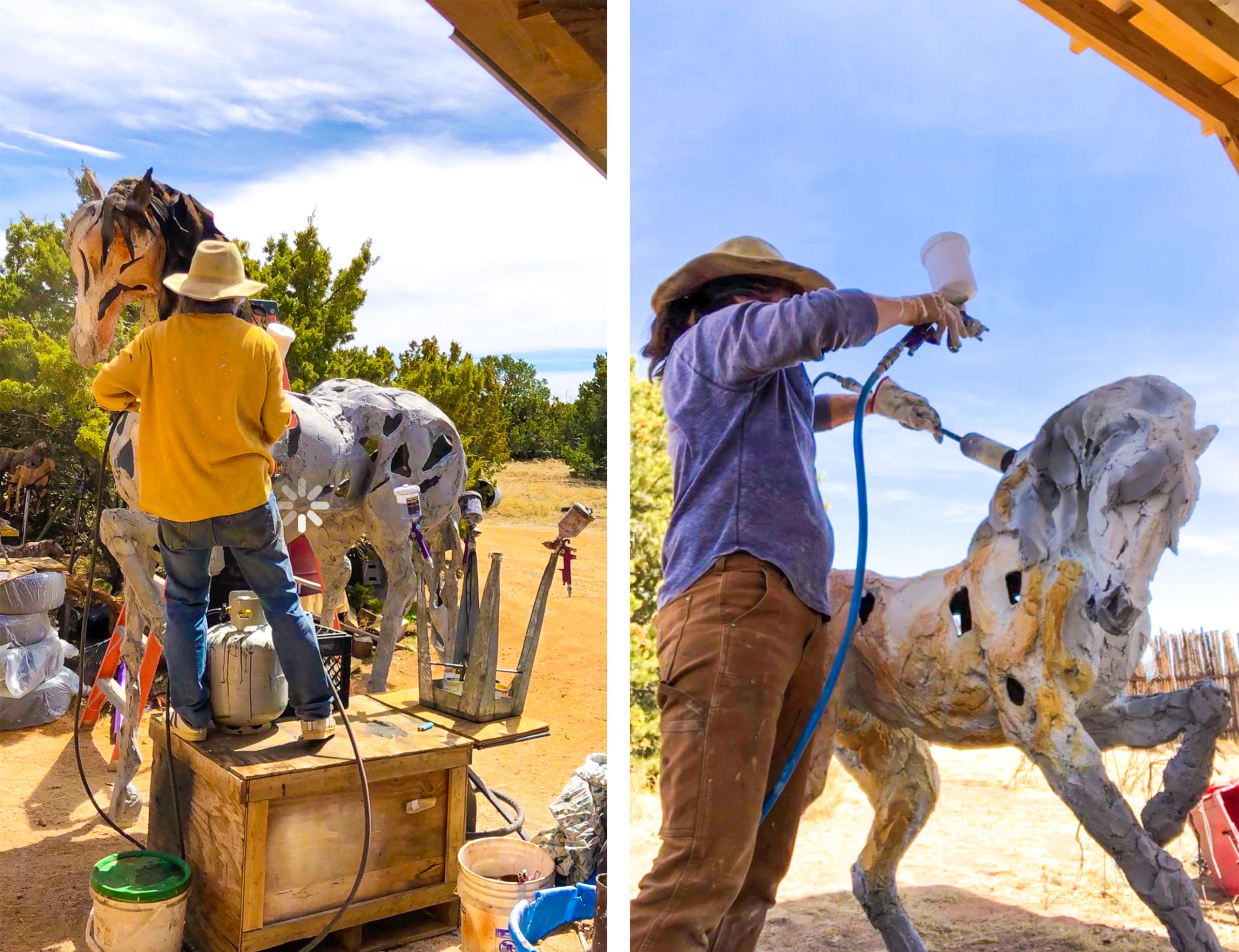
Siri Hollander sculpting two of her equestrian pieces outside her studio in Santa Fe
Early on in her art career, she tried working with clay only to find it too fragile. She wanted to create large-scale pieces that could weather and withstand the test of time; therefore, she needed something far more durable and resilient to the elements. As a predominantly self-taught artist, Hollander began experimenting with various materials, using her childhood experiences as inspiration. Autodidactic experimentation yielded her signature mixture of cement and sand from local riverbeds. This alluvial blend, half sourced from the Santa Fe Mountains, produces uniquely rugged textures for her welded steel yearlings.
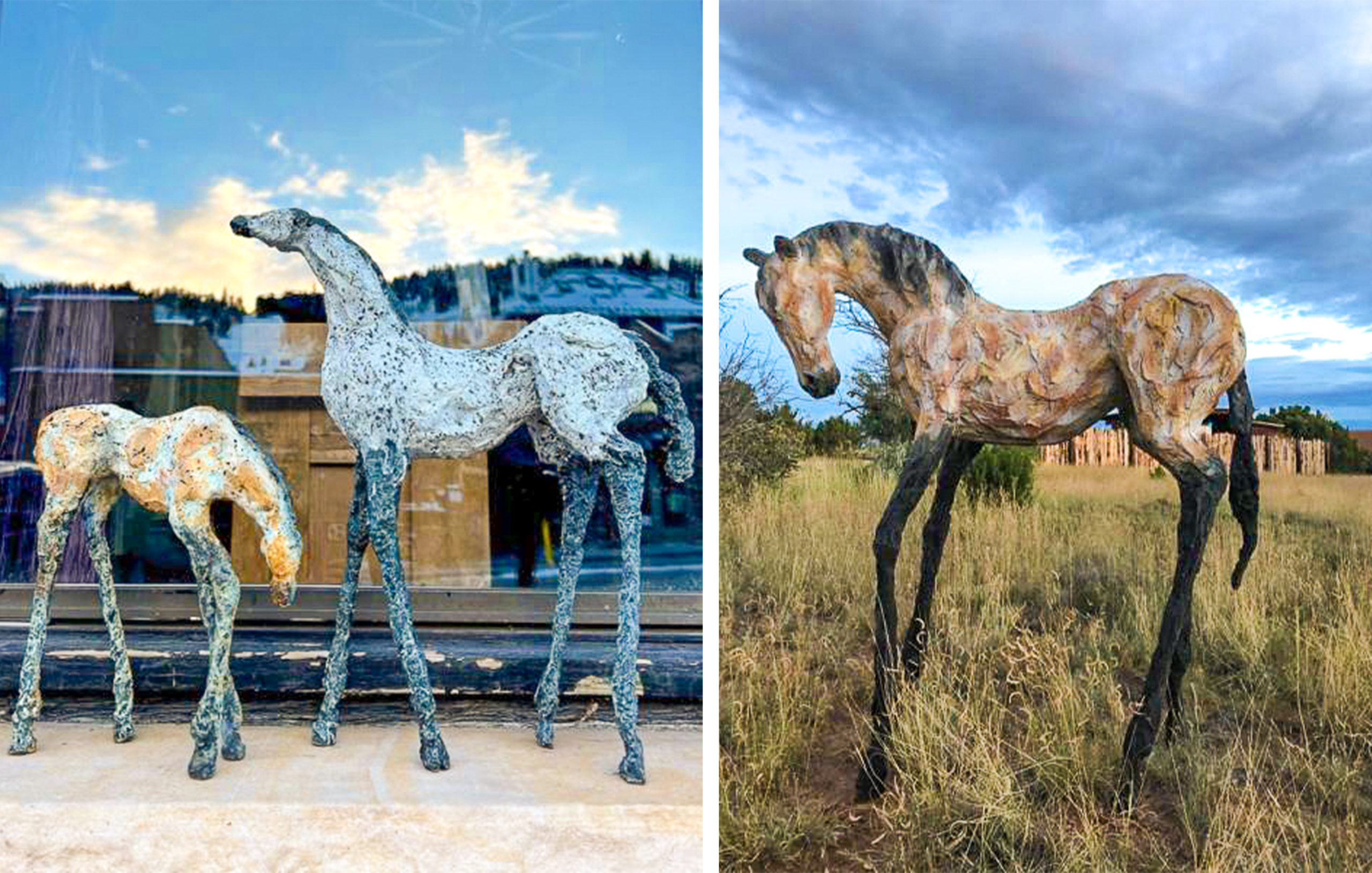
Left to right: Siri Hollander, “Apio & Cria,” bronze | Siri Hollander, “Chika 2/30,” aluminum, 60″ x 53″ x 15″
We are now proud to represent the wild, stunning work of Siri Hollander at Gallery MAR. Hollander relies heavily on her intuition in her life and her work and feels strongly that it was fate that connected her work with Gallery MAR. When Gallery MAR owner, Maren Mullin, first met and introduced herself to Hollander in Santa Fe, Hollander remembers feeling like “it was meant to be.” Hollander’s especially comforted by the confidence she feels in Gallery MAR to show her larger-scale works of art. She has been especially drawn of late to create larger-than-life works that properly express the grandeur and magnificence of her equine inspiration.
“Freedom is the message I would put out there. When I am around my horses, dogs, kids, animals, I try to let them be as opposed to making them obey. In the same way, I am grateful to have the privilege to just be myself.”
– Siri Hollander
Creating large-scale works, especially those destined for outdoor installation, has become increasingly important to Hollander in later years. She remembers how much large-scale public art installations influenced her in her early years in Spain, and wants to offer that same inspiring experience to the next generation. “I like the fact that with public art installations, children and all kinds of people can get something out of interacting with art. It’s something that I can personally share that can have an impression on people. For me, freedom is the message I would put out there, if a message is of interest. When I am around my horses, dogs, kids, animals, I try to let them be as opposed to making them obey. In the same way, I am grateful to have the privilege to just be myself.”
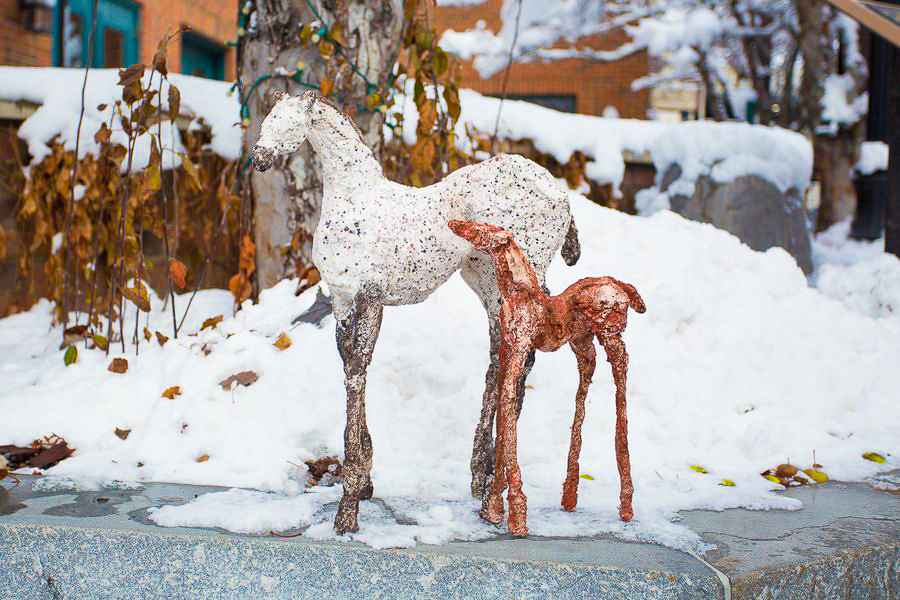
Siri Hollander, “Mamita,” mixed media, 19″ x 17″ x 9″
We have loved seeing people’s reactions to the work of Siri Hollander in Gallery MAR and look forward to connecting these wild horses with people who will cherish them for generations to come. Stop by the gallery today or check out Siri Hollander’s work on our website to see which of her wild horses inspires you most.
 Studio Stories: America Martin
Studio Stories: America Martin Gallery MAR Holiday Gift Guide 2025
Gallery MAR Holiday Gift Guide 2025 The Art of People - Capturing Sonder
The Art of People - Capturing Sonder